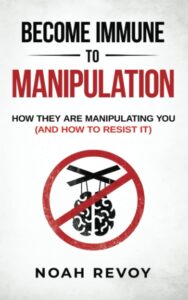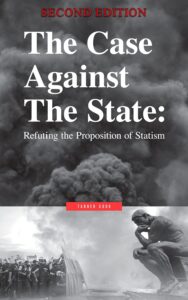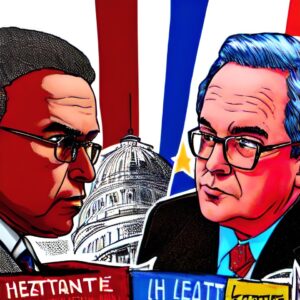In the sphere of societal dynamics, the manipulation of thought and control of narrative has been used as a powerful tool to shape public opinion and behavior. One method that has found recurrent usage is the dichotomy, or the process of splitting concepts into two opposing camps.
Left vs. Right: Polarization in Politics
The dichotomy in politics, often represented as Left vs Right or Democrats vs Republicans, serves as a classic example of how societies are manipulated. The division is much deeper than policy disagreements, it reaches into the realms of ideology, personal belief systems, and even individual lifestyles.
This separation fuels an adversarial mindset, transforming the opposition from simply individuals with different views into perceived enemies. Politicians and media channels effectively utilize this dichotomy as a tool to sway the masses. This leads to a politically charged atmosphere where reaching a compromise becomes a herculean task and any chances of constructive discussions are replaced with antagonism.
Red vs. Blue: How Colors Shape our Ideologies
In the world of politics, the colors red and blue carry more weight than one might initially think. They’re no longer merely hues on a color spectrum, but symbolic representations of the ideological chasm between two major political parties in America: the Republicans (red) and the Democrats (blue). This simple, yet powerful association has turned into a form of subconscious programming, effectively creating division and arousing partisan sentiment.
The link between colors and party affiliation has proven so powerful, it has the ability to prompt immediate judgments and biases based solely on a color that stands for a political entity. This type of color-coded political labeling provides a quick, visual way of recognizing where someone stands politically, but it also solidifies the dichotomy, further polarizing citizens. By symbolizing complex political ideologies with simple color labels, the true complexities of political issues and ideologies can get lost, reducing nuanced debates to color-coded tribalism.
White vs. Black: Racial Divide as a Tool for Control
The dichotomy of White vs Black, often used to characterize racial dynamics, is another powerful tool of division. By perpetuating and reinforcing racial stereotypes, this narrative serves to fuel racial tensions and hinder societal unity. When societies are divided along racial lines, maintaining control becomes significantly easier, as the focus is deflected towards blaming the ‘other’ rather than addressing systemic and institutionalized issues.
This racial polarization fosters an ongoing cycle of misunderstanding, mistrust, and hostility, stripping away the chance to nurture a truly equitable community. It creates an environment where individuals are categorized and judged solely based on their racial identities rather than their individual qualities or actions. This level of racial polarization often obstructs productive conversation and the possibility of bridging the racial divide. Consequently, it obstructs the path towards societal harmony and equality, while securing the power structures that benefit from such division.

> Check Current Book Prices <
Propaganda and the Power of Narrative
The infusion of propaganda into mainstream channels has been a significant component in fostering dichotomy-based control. A narrative, carefully crafted and maneuvered, has the ability to shift perceptions and dictate behaviors on a mass scale. Major players in this sphere, such as media corporations, political figures, and individuals with widespread influence, wield this power to their advantage. They utilize techniques such as storytelling steeped in emotional appeal, cherry-picking information to fit their narratives, and distorting facts to further their agenda of fake news.
In the current digital age, the constant barrage of information can make it increasingly challenging to distinguish between factual news and propagandistic content. This difficulty often provides fertile ground for the proliferation of dichotomies, with the audience often left in a state of confusion or tension. It’s not uncommon for individuals to form opinions or make decisions based on these narratives, which can lead to polarized public sentiment and behavioral changes. This, in turn, makes it easier for those in power to manipulate the masses and assert control. Through propaganda and the masterful manipulation of narratives, the perpetuation of dichotomies continues unabated, fueling division and discord in society.



Crisis Actors are the Fuel for Dichotomy-Based Control
Individuals known as crisis actors are often the ignition for dichotomy-based control, acting as key players in the grand scheme of manipulation. These individuals typically play roles as victims or perpetrators during times of crisis, becoming the faces that come to represent specific, often divisive narratives.
Instances of this can range from situations steeped in political scandal to incidents that ignite racial tensions or even events believed to be false flag operations. Each crisis becomes an opportunity to exploit and amplify societal divisions. By tapping into raw, powerful emotions such as fear and anger, these actors, whether knowingly or unknowingly, help to mold public perception and sentiment, adding fuel to the fire of division.
The narratives surrounding these crises can be manipulated and spun in a way that serves the interests of those in power, allowing for greater control over the population’s reactions and beliefs. By understanding the role of crisis actors in this manipulative dichotomy, we can better recognize and resist such tactics, staying aware of the potential for distortion and misinformation that feeds societal division.
Counteracting the Divide and Conquer Strategy
To counter the pervasive divide and conquer strategy, heightened awareness is critical. One must comprehend the strategic tools of manipulation and the objectives they serve. Be a diligent consumer of information, question prevailing narratives, and challenge the inherent dichotomies that often come with them. Foster conversation rather than competitive debate, and promote understanding in place of division.
Look beyond the binary oppositions of political affiliations, racial divides, and ideological differences. It’s important to remember that these dichotomies are often designed to divide us and thus make us easier to control. Instead, seek out common ground and shared values, recognizing the diversity and complexity within each individual. Understand that reducing people or beliefs to simple dichotomies limits our perspective and hinders productive dialogue. As we strive to move beyond these dichotomies, we can begin to dismantle the tools of manipulation and control, replacing division with unity.
Ultimately, it’s unity in diversity that shields us from manipulative tactics, and our shared human experience is a stronger bond than any artificial division. Through awareness and understanding, we can counteract divisive strategies and work toward a more harmonious society.







